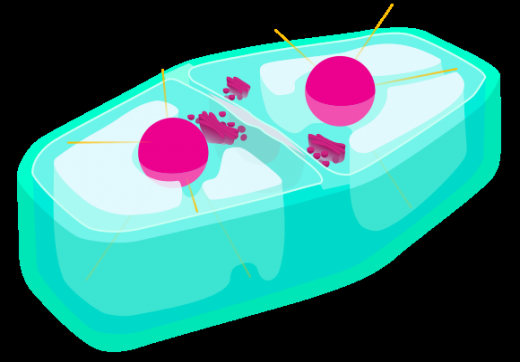What is Plant Mitosis?
 Nicole Madison
Nicole Madison
Plant mitosis is the process through which a plant cell divides and creates two identical copies of itself, which are referred to as daughter cells. Each of the daughter cells gets a complete copy of the genetic material contained in its parent cell. The phases of plant mitosis are interphase, prophase, metaphase, anaphase, telophase, and cytokinesis.
During interphase, also referred to as a cell’s resting stage, a plant cell prepares for mitosis. At this point, a cell is going about its normal business. For example, a cell is duplicating chromosomes during this stage. Interphase is sometimes listed at the end of plant mitosis descriptions, depending on the scientific source.

In prophase, genetic material called chromatin condenses and forms chromosomes. The chromosomes are connected together to make pairs joined at a central point called the centromere. Outside the nucleus, structures called centrosomes develop. Their job is to create hollow rods called microtubules. In preparation for the metaphase stage of plant mitosis, the microtubules enter the nucleus and attach to the chromosomes at their centromeres.
During metaphase of plant mitosis, the centromeres with the attached microtubules move to different ends of the cell. This results in the pulling of the chromosomes toward opposite ends of the cell. The centromeres begin to form a point of separation during this stage.
In the anaphase stage of plant mitosis, the chromosome pairs separate and half of a pair migrates to one end of the cell while the other half moves to the other end. Microtubules in the cell work to lengthen the plant cell. This prepares the cell for telophase.
When a plant cell is in telophase, its microtubules and centrosomes disintegrate. The leftover nucleus from the original cell creates a nucleus around the chromosomes at opposite ends of the cell. At this point, the chromosomes turn into chromatin once more.
When the plant cell enters cytokinesis, it has yet to divide into two independent cells. The cell develops a cell plate at this point, which serves to divide the single cell into two separate daughter cells. The two new daughter cells then pull apart from each other, with each one in possession of an exact copy of the original cell’s genetic material.
Plant mitosis is much like animal mitosis. The major difference is that animal cells do not develop a cell plate. Instead, the animal cell pinches off in the middle in order to separate into two cells.
AS FEATURED ON:
AS FEATURED ON:











Discussion Comments
@cardsfan27 - Great information. We are learning about mitosis in class, too, but we didn't really talk about the use of the cell wall.
What happens to the cell organelles during mitosis? In plants, there is a large vacuole that holds water and nutrients for the cell. Is it split by the cell plate, or does a new vacuole form in the daughter cell? Also, how does the plant decide what organelles will end up in the new cell?
This was an excellent description of how the genetic material is transferred during mitosis. I think most sources over-complicate the process.
I also wanted to add something that we discussed in class the other day. The reason the cell plate forms is because plant cells have a cell wall that is lacking in animal cells. The cell wall is made of up different fibers that allow plants like trees to grow very tall and develop wood. Because these fibers are lacking in animals, we have to have bones and other support structures.
Post your comments